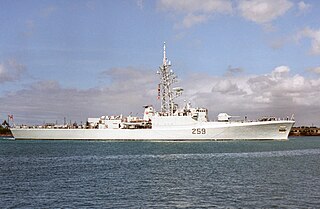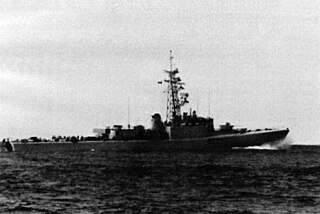Related Research Articles
Several Canadian naval ships have been named HMCS Athabaskan. All named for the Athabaskan people and destroyers. First ship was British built, the other two in Canada.

HMCS Terra Nova was a Restigouche-class destroyer that served in the Royal Canadian Navy and later the Canadian Forces from 1959 until 1997. After her final refit, she was a guided missile destroyer.
Four Canadian naval units have been named HMCS Ottawa.
Several Canadian naval units have been named HMCS Chaudiere.

HMCS Restigouche was the lead ship of the Restigouche-class destroyers that served in the Royal Canadian Navy and later the Canadian Forces. Commissioned in 1958, Restigouche remained in service until 1994. She was sold for use as an artificial reef, however controversy arose over her acquisition and instead she was scuttled off the coast of Mexico in 2001. She was the second Canadian warship to carry the name HMCS Restigouche.

Vice Admiral Henry George DeWolf was a Canadian naval officer who was famous as the first commander of HMCS Haida during the Second World War.
Several Canadian naval units have been named HMCS Kootenay.

HMCS Kootenay was a Restigouche-class destroyer escort that served in the Royal Canadian Navy and Canadian Forces from 1959 until 1996. She was the fifth ship in her class and the second vessel to carry the designation HMCS Kootenay. The ship suffered two serious incidents in her career: a 1969 explosion and ensuing fire that killed nine, and a 1989 collision that required the complete replacement of her bow. Following her service, the ship was sunk as an artificial reef.
HMCS Qu'Appelle can refer to several different things named after the Qu'Appelle River in Saskatchewan:
The Royal Canadian Navy uses hull classification symbols to identify the types of its ships, which are similar to the United States Navy's hull classification symbol system. The Royal Navy and some European and Commonwealth navies use a somewhat analogous system of pennant numbers.
Several Canadian naval units have been named HMCS St. Laurent.
Several Canadian naval units have been named HMCS Gatineau.

HMCS Saskatchewan was a Mackenzie-class destroyer that served in the Royal Canadian Navy (RCN) and later the Canadian Forces. She was the second Canadian naval unit to bear the name HMCS Saskatchewan. The ship was named for the Saskatchewan River which runs from Saskatchewan to Manitoba in Canada.
Several Canadian naval units have been named HMCS Saskatchewan.

The River class was a class of fourteen destroyers of the Royal Canadian Navy (RCN) that served before and during the Second World War. They were named after Canadian rivers.

HMCS Chaudière was a Restigouche-class destroyer and the second vessel of her class that served in the Royal Canadian Navy and later the Canadian Forces from 1959 to 1974. She was the second Canadian naval unit to bear this name. During the summer of 1974 she along with her sister ship HMCS Columbia served as the base of operations for the Esquimalt Sea Cadet Camp while being docked at the DND jetty in Colwood. This location was across the harbour from the main site of CFB Esquimalt. Following the vessel's decommissioning, the ship was used as a source for spare parts for the other surviving members of her class. In 1991, Chaudière was sold for use as an artificial reef and sunk off the coast of British Columbia.
Two ships of the Canadian navy have been named HMCS St. Croix.

HMCS Columbia was a Restigouche-class destroyer that served in the Royal Canadian Navy and later the Canadian Forces from 1959 to 1974. Columbia was the seventh and final ship in her class and is the second Canadian naval unit to carry the name HMCS Columbia. Following her service, she was kept at Esquimalt in an altered condition, no longer capable of sailing. During the summer of 1974 she along with her sister ship HMCS Chaudiere served as the base of operations for the Esquimalt Sea Cadet Camp while being docked at the DND jetty in Colwood. This location was across the harbour from the main site of CFB Esquimalt. Columbia was sold for use as an artificial reef and sunk off the coast of British Columbia in 1996.
Several Canadian naval units have been named HMCS Columbia.
The Battle of Pierres Noires was a naval action that occurred during the Allied Operation Dredger, involving several Royal Canadian Navy (RCN) destroyers and a German Kriegsmarine U-boat with escorts near Brest, France. The RCN force managed to sink or damage some of the escorts on the surface, but the U-boat was able to escape.